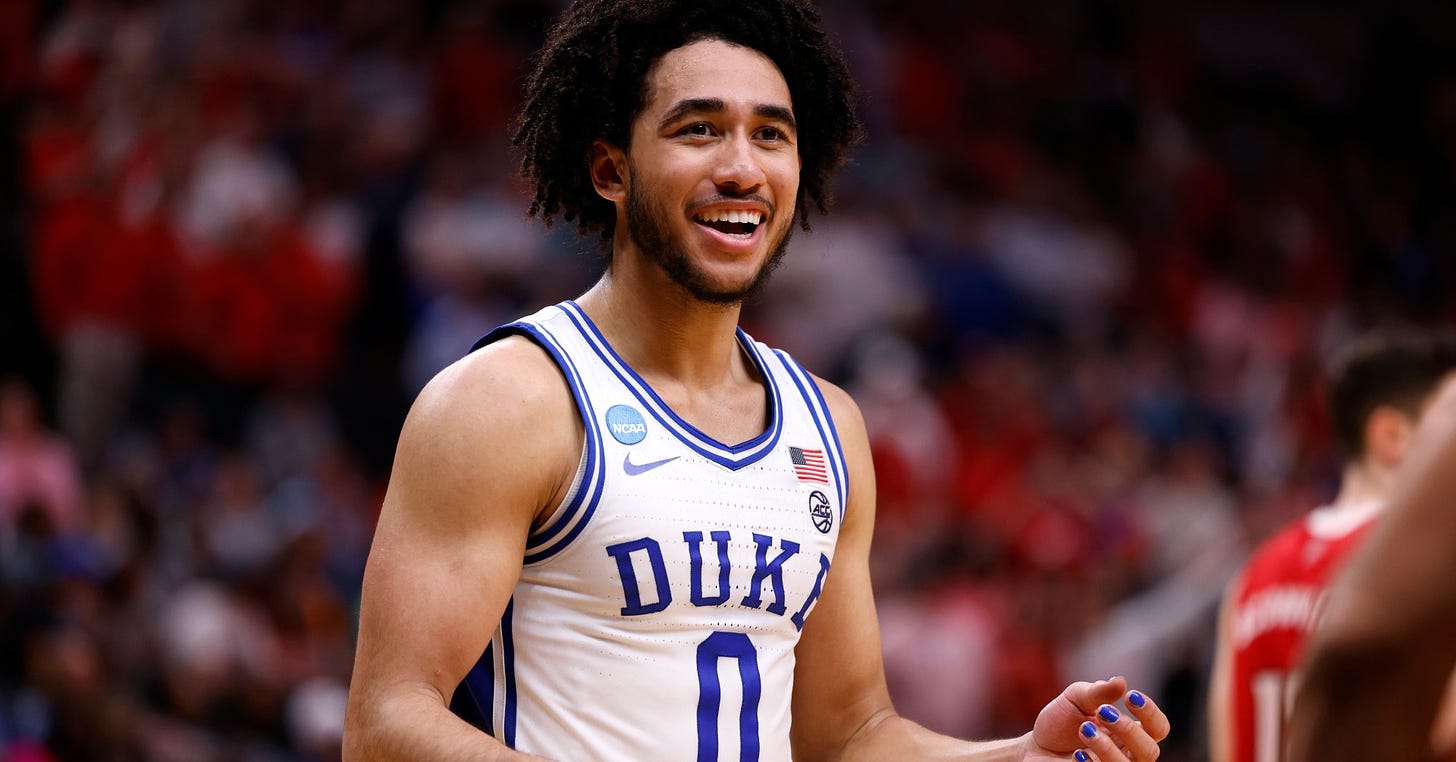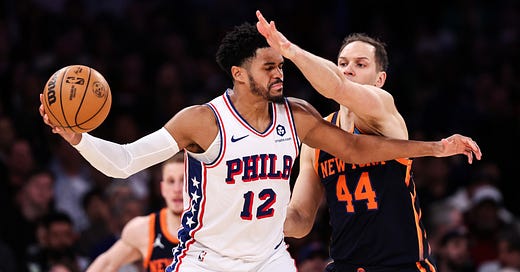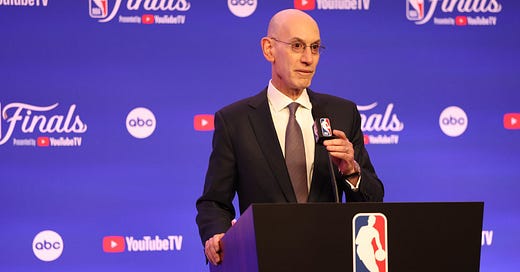
How Jared McCain Fits With the Sixers
Duke’s sharpshooter and TikTok megastar is headed to Philly.
Here’s the entire list of college basketball players who were drafted last night who shot at least 40% from three on more than 200 attempts last season:
Jared McCain. That’s it. End of list.
Does a hyper-specific query like that really tell you all that much about the quality of an individual player? Most likely not. But it does highlight one thing — in one of the worst draft classes in recent NBA history, Daryl Morey and the Philadelphia 76ers targeted one of the few players with a truly elite skill.
Anyone who’s followed my work for the past new months knows the sell on McCain — a deadeye shooter who plays with enough strength and craft in other areas to make up for the fact that he stands a mere 6-foot-2 with a 6-foot-3.5 wingspan. (Funny enough, those are pretty much the exact physical measurements of one Steph Curry, an all-time great despite a somewhat lacking athletic profile by NBA standards).
Producing this well as a freshman for a Duke team that actually made the Elite Eight matters a whole heck of a lot.
Those 87 threes that McCain drilled across 36 games while wearing a Blue Devils’ uniform fell into a number of different categories.
Duke ran a good number of “Floppy” sets in the halfcourt to get McCain open looks for movement threes, and he did well to work as an off-ball mover and get himself open coming up from the baseline (Nick Nurse ran Floppy for Tyrese Maxey, Buddy Hield, and Cameron Payne quite a bit latest season). At the top of the key, Duke also loved to clear out an empty corner and give McCain a quick-hitting flare screen, hoping to catch defenses off-guard and get college basketball’s best sniper a clean look.
In transition, there was nothing McCain loved to do more than sprint the floor as fast as he possibly could and hunt an open triple from the slot. Despite having a wide-set base when he shoots, McCain has an unbelievably quick trigger and does a great job chopping his feet so that he’s always square to the basket when he releases the ball.
He clearly understood what his job was as a shooter, and he spent all 36 games at Duke last season hunting out three-point opportunities like a maniac.
As Sixers fans (unfortunately) saw with Celtics’ role player Sam Hauser this postseason, no-dip threes have become an essential tool for spot-up shooting role players. Being able to nail a three despite catching the ball in a slightly unfavorable position is just such an invaluable skill to a good offense. McCain, while sometimes being discouraged from a shot by a ferocious closeout of a much taller opponent, is great at speeding up his release and keeping the ball high after receiving a pass. He has some athletic limitations that could make it hard for him to get as many threes off as people would like, but he clearly understands his own weaknesses and has worked to built up skills that compensate for those.
The size and burst deficiencies are obviously the most worrying thing about the McCain pick, especially when the Sixers’ only current backcourt fixture already stands at just 6-foot-1. Defensively, it will certainly be tricky to pair the two, as they quite often would be the two shortest players on the court. Maxey’s improvement as an on-ball defender and guarding up against slightly bigger wings this past year alleviates some of the concern, as does McCain’s rock-solid build that allowed him to at least hold his ground inside at Duke. But it’s a puzzle for the Sixers to solve nonetheless.
The same could be true on offense, with McCain projecting almost exclusively as an off-ball scorer rather than an on-ball creator. Sure, there’s nothing wrong with keeping the ball in Maxey’s hands, though his best role on offense is as a combo guard, not as the pure point. Maxey is too good at flying off screens for threes and attacking tilted defenses to play him as a pure on-ball point guard who just spams pick and rolls possession after possession.
McCain certainly can’t step in and play pure point from day one in the NBA, but he has more on-ball equity than he’s been given credit for. At Duke, he played next to point guard Tyrese Proctor, who’s a fringe NBA prospect, but often needed the ball in his hands to operate at his best. The same can be said for McCain’s veteran teammate Jeremy Roach, and this doesn’t even mention the designed post touches for the yet-to-be-drafted Kyle Filipowski. All that to say, McCain didn’t get many on-ball reps at Duke because he was far and away the team’s best off-ball player, while his teammates really needed the rock in order to do what they do best.
Per Synergy, McCain ran 123 pick and rolls this past season, and Duke averaged 0.992 points per possession on those plays, a pretty solid mark. He doesn’t have the lower half flexibility to slide past on-ball defenders and collapse defenses inward, but he has a great sense of basketball geometry and knows which areas of the court are best to access. He also understands the gravity he holds as a nuclear shooter and how defenses react to the very threat of him coming open off a screen. His tape is littered with empty corner assists, and he has a great feel for hitting rolling big men.
It won’t be his go-to trait from day one, but McCain can handle and distribute the ball well enough to keep the Sixers’ offense humming. It might not happen immediately, but I’m fairly confident that in time McCain will be able to serve as the Sixers’ lead guard in non-Maxey lineups, moving the ball where it needs to go and keeping the offense apace with his lights out shooting. McCain-led lineups might require more ball handling at the forward positions than the usual five-man fixture – though honestly, it might be good for the Sixers to have a surplus of big ball handlers anyways, given Maxey’s proclivity to play off-ball as well.
I’ve said it before and I’ll say it again — the most likely long term outcome for McCain is that he becomes a fun and helpful sixth man. He’s a special, special shooter, and has enough versatile offensive skills that he’ll always find ways to score the ball efficiently. But it’s important to remember how unlikely it is for small guards to be big-time superstars. The Tyrese Maxey story is a miraculous one for the Sixers because most 6-foot-1 players don’t also have condor-like wingspans, the most insatiable work ethic known to mankind, truly generational touch on odd-angle layups and floaters, unlimited three-point range and the clutch gene. More often they’re like McCain — very good players with some elite ball skills, but lacking in certain areas just enough that star upside seems unlikely.
And that’s fine. In a bad draft class, where it feels like both the ceiling and the floor of so many different prospects could fall out, McCain has an easily bankable elite skill, and it’s one that’s incredibly important to winning basketball at the highest levels. Walking out of a bad draft with a great sixth man at the 16th overall pick is a huge win, and that’s what the Sixers might have landed in Jared McCain.

















